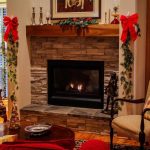
A fireplace is often the focal point of a room. Although fireplaces are popular as a primary heating source worldwide, they are also considered an essential amenity. A well-built fireplace can significantly add to your home’s resale value. More than anything, it brings comfort and warmth to your living space. Instead of just turning the HVAC system on, it’s a lot more pleasing to see the dancing flames change colors and hear the crackle of firewood on a cold, rainy evening.
If you still don’t have a fireplace and are considering your options, the following guide might come in handy:
Choosing The Right Size
There is no universal fireplace size—the exact dimensions depend on the size of the room. You might also need to consider the power output in this case. Your fireplace installation company will guide you with the right output needed according to the size of the room. If you opt for a larger size, the power output will also be higher. In this case, you might have to use a dampener to keep the flames low, or else the room will heat up too much. If the fireplace burns excessively, you could also end up dealing with chimney problems like soot buildup.
Alternatively, if the fireplace is too small, the room won’t warm up enough.
As a rule of thumb, multiply the height, length, and width of the room (in meters) and further multiply this number by 0.07. The resultant answer will give you the ideal number of kW. Never get a fireplace with the intention of heating more than one room. Most homeowners incorrectly assume that this will help them save up on energy bills. In reality, it’ll overheat the main room and force you to keep the fireplace off most of the day.
Define The Purpose
You need to be clear about why you need a fireplace in the first place. Do you need one to warm up the room or for aesthetics? Are you opting for a combination of both? When you reach out to the installation company, tell them your purpose to narrow down the selection process.
If your goal is heating efficiency, you should get a self-modulated and thermostat-controlled fireplace. Such fireplaces automatically adjust to maintain a steady and regulated indoor temperature. If your purpose is aesthetics, start by deciding on a fireplace insert. Look for a design that matches your existing decorating style seamlessly. You might not be able to review all the available designs at the showroom, so ask the salesperson to show you the brochure and take a thorough look. You can also get them to install a custom-designed piece that blends with the rest of your home interior.
Open Or Closed Fireplace?
A fireplace essentially serves two purposes:
- Warmth
- Ambiance
As a homeowner, you want to strike a sweet balance between the two. This brings us to the question of whether the fireplace should be open or closed. If you love the idea of a fireplace lighting up your evenings, are fond of the dancing flames, and the log fire’s crackle, an open grate is a right choice. Open fireplaces look cozy and add a very eighteenth-century, rustic feel to your living room.
The downside is that most of the heat generated by an open fireplace is lost up the chimney. Such fireplaces need frequent maintenance efforts. You will have to clean up the ash and other residues regularly. To make things easier, we recommend seeking some help from a professional chimney cleaning service.
The other option is to invest in a closed fireplace. These are more expensive compared to open fireplaces because of their higher efficiency. Since there are no heat losses through chimneys, these types of fireplaces burn less coal and heat up the room quickly. Most of the heat generated by close fireplaces go into warming up the room, making them a lot cleaner to run. Closed fireplaces come in a variety of options, including cast iron and steel.
The downside to closed fireplaces is that there is no chimney. Chimneys need to be inspected regularly to prevent soot buildup. In the case of closed fireplaces, most of the sticky, tar-like deposits collect inside the fireplace itself. This could make the cleaning process a lot harder for you.
Gas Or Electric Fireplace?
This decision depends on a number of factors. If your house already has a gas line, installing a gas fireplace won’t need many modifications. If you don’t have one, the process will naturally be more tedious. You’ll have to bear the initial cost of installing a propane tank, which takes up significant space. You might also find it hard to hide the tank within the existing fireplace.
In this case, an electric fireplace might make more sense. Electric fireplaces are also a safer option since they don’t create any flames. If you’ve got pets or toddlers running around the living house, you should get an electric fireplace.
If you’re installing a gas fireplace, you’ll need to install a chimney, vents, and a smoke chamber. On the other hand, electric fireplaces are factory-wired and only need to be plugged into a wall outlet. Due to the elaborate installation process, gas fireplaces are more costly to deal with.
The author is a regular contributor to the blog and has been associated with Creative Masonry & Chimney as a fireplace construction expert. The company is one of the leading providers of chimney repair and installation services in Connecticut and has been serving the state for the past thirty years. The company’s services include chimney cleanup, repair, and installation. Other than that, the team also specializes in masonry services that include fireplace repair, building, and remodeling. Creative Masonry & Chimney is your one-stop solution for all fireplace needs.






